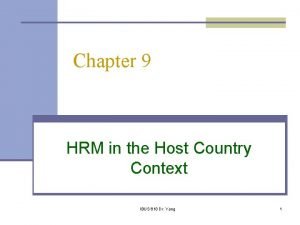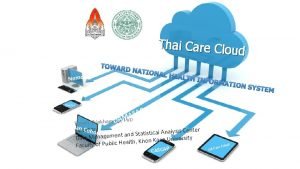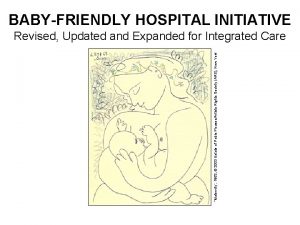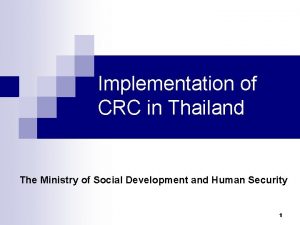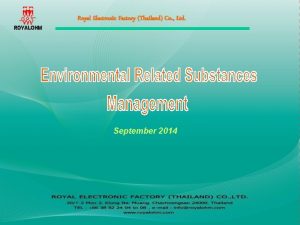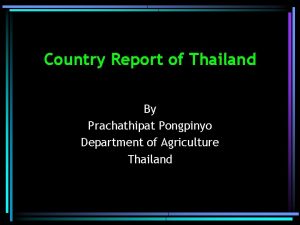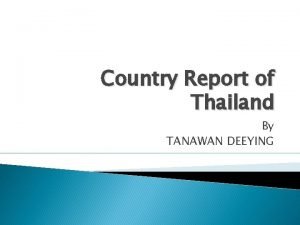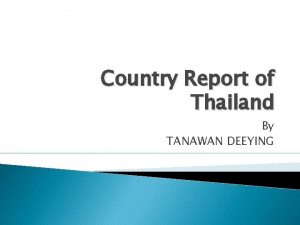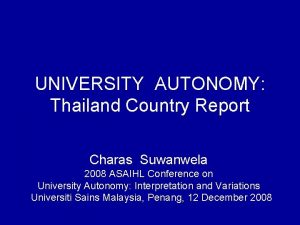Thailand country report Dr Somchai Durongdej Department of




























- Slides: 28

Thailand country report Dr Somchai Durongdej Department of Nutrition, Mahidol University Faculty of Public Health Ms Pitsawat Buara Horticultural Research Institute, Dept of Agriculture,

Thailand policy on fruit and vegetables production and consumption l l l Make national food and agricultural policies consistent with the protection and promotion of public health Develop diet strategies and guidelines Start nutrition education, media literacy primary school - to promote healthier diets, counter food fads and misleading dietary advice Encourage positive, healthy messages Coordinate school policies with health priorities

Production of F&V Fruit and vegetable produced in Thailand were mainly for domestic consumption (population 62. 4 m)

Average availability of F&V for domestic consumption Food items Fruit Average availability Gms person per day 330 -350 Vegetable 190 -200 Total 520 -550

Threats to the production Fruit and vegetable production in tropical regions faces a lot of problems - insect pests - diseases - poor standard - high residues of pesticide exceed the MRL

Crop production situation In 1991 started pilot projects for hygienic production of pesticide “safe” fresh fruits and vegetable. - promoting IPC - introduction of microbial organism used - natural enemy insects and plant extraction used instead of chemical application.

Future trend of green and organic vegetable consumption In 2003, Thailand defined itself as the world’s Kitchen and addressed the food safety year. Agricultural products export increases 10% each year.

Quality Improvement on green and organic vegetable production - In 2003: 12 kinds of fruits and vegetable are recommended to produce under GAP procedures - In 2004: 29 kinds of fruits and vegetable are produced under GAP and GMP procedures

National Requirements - Ministry of Agriculture & Cooperatives promotes and encourages growers to comply with GAP guidelines (enforced by Department of Agriculture) - Q logo is the sign for Thai food crops produced under GAP farms that are safe and meet standards and requirements of both export and domestic market.


National Requirements “Q” for “quality” At present, the Department of Agriculture grants several “Q” Certifications including. - Q shop (agricultural inputs shop) - Q GAP (farm) - Q packing house (GMP) - Q processing factories (GMP/ HACCP) - Q Fumigation (SO 2) - Q Food safety (Q certifications of packing house + Q GAP farm + Analysis of their products with safety requirements)

Status of Farms under certification with GAP in 2006 (n=501, 663)

certifications given on fruits and vegetables 5. longan durian mangosteen vegetables baby corn 6. asparagus 1. 2. 3. 4.

Interventions to promote F&V consumption in Thailand l Promoting Healthy weight l Promoting more consumption of Fruit and vegetables l Focus on School based Interventions

Promoting Healthy weight Issue: unhealthy weight gain is a major contributor to ill health. l What is being done 1. Dissemination of FBDG 2. Actions focus on healthy eating 3. Health promoting schools 4. Model intervention project l

Fruit and vegetables promotion l Issues; not consume enough fruit and vegetables l What is being done 1. Healthy eating communication 2. Survey of fruit and vegetables consumption in school children 3. Identify school based interventions for increasing fruit and vegetable consumption

Why Intervene in Schools? l Schools have most continuous contact with young children l Many children eat 2 meals a day at school l Children eat more than half their daily calories at school l Thus school-based interventions have powerful potential to influence dietary behavior

Why the Need? 15% of Thai children overweight l Prevalence has doubled in past 2 decades l Overweight children have more health complications; more likely to become obese adults l

Convinced situation? l World Health Report shows that adequate fruit and vegetable consumption can decrease obesity risk l According to 2003 national nutrition Survey in Thailand, only 15% of adolescent students reported eating at least five servings of fruits and vegetables per day

major networks for fruit and vegetable consumption Mass Communications and Education Research New Policy Development Increased intake Environmental change Partnership development

Consumption of fruit and vegetable in school children

Key Project Elements Goal: Positively impact F&V consumptions for students and their families l Multi-component approach, comprising: l l l Nutrition promotion Family participation Cooking demonstrations School garden Mid-morning snack (Fruit and Vegetable Program)

Stakeholders l WHO & FAO and other UN agencies l The Local authorities l University and Research institutions l Parental Association l Ministries of Health, Agriculture and education. l NGOs and Community Leaders

Promotion in adults not in children

Recommendations and Conclusions

Plan for further actions l l l Increase the availability and safety of fruit and vegetables for consumption Identify sustainable activities for increasing the consumption of FV Establish nutrition standards for school cafeterias Establish means for Parental involvement Build a strong evidence-based fruit and vegetables interventions that are appropriate for school settings Establish a network for promotion of Fruit and vegetables

Acknowledgements l Funding l WHO, agencies FAO l Ministries of Public Health, Education, Agriculture and NGO l Business leaders throughout Thailand that participated in the research

Thank You
 Somchai jaidee
Somchai jaidee Somchai jaidee record
Somchai jaidee record Somchai jaidee vk
Somchai jaidee vk Host country and home country
Host country and home country Intra country vs inter country
Intra country vs inter country Cris txdot
Cris txdot Gibbons thailand
Gibbons thailand Business opportunities in thailand
Business opportunities in thailand Thailand vision
Thailand vision Dmht thailand
Dmht thailand Thailand traditional instruments
Thailand traditional instruments Adra thailand
Adra thailand Stem cell phuket
Stem cell phuket Tourism law thailand
Tourism law thailand Economic aspects of marriage
Economic aspects of marriage Breastfeeding thailand
Breastfeeding thailand Jupiter logistics (thailand) co. ltd
Jupiter logistics (thailand) co. ltd What countries border thailand
What countries border thailand The river rehab thailand
The river rehab thailand Fls 1993
Fls 1993 Giscont
Giscont Renewable energy law thailand
Renewable energy law thailand Proper adjective
Proper adjective Tourism law thailand
Tourism law thailand Crc thailand
Crc thailand Royal electronic factory
Royal electronic factory Swot thailand
Swot thailand Assumption primary school bangkok
Assumption primary school bangkok Thairen
Thairen



